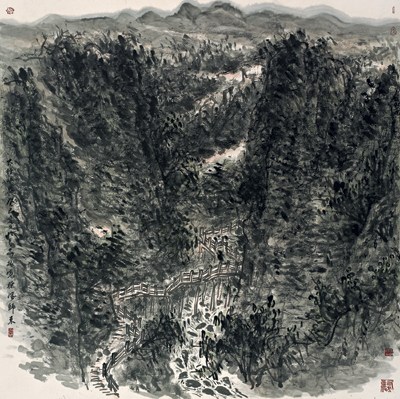
Ink painter Cui Zhenkuan captures the relationship between humans and nature with his unique brushstrokes, which is highlighted in his ongoing solo show in Beijing. (Photo provided to China Daily)
Cui's dense, wrinkled strokes on paper look like markings with an ax. He takes great delight in seeking a sense of freedom amid the intensive, forceful brushstrokes.
The artist also uses his brush as a force of calligraphy. His passion can partly be traced back to his childhood, when his family collected calligraphic rubbings on ancient stone tablets.
He has created an imposing visual art profile for himself by building up a distinctive palette.
He found that normal color pigments don't go well with thick ink strokes or blocks to generate a smooth, transparent effect.
So he mixed ink with gold and silver pigments-sometimes also adding red and blue-to produce a metal-like texture.
A native of Northwest China's Shaanxi province, Cui also sources inspiration from the Chang'an Painting School, which in the 1960s produced artists who extensively painted landscapes and people of that region, depicting everyday life.
Reaching out
Cui has spent years traveling and sketching in a bid to follow the school's motto-"one hand reaches out to the tradition, another hand reaches to real life".
Chinese painters used to create artworks based on subjective feelings, stressing pictorial imagery, rather than real-life issues, says Cui.
"When traditional Chinese paintings were transformed with a modern outlook, painters were forced to give up the seclusion of 'literati painting' and turn to the real world and the people living in it."
He portrays the magnificence of mountain stretches as well as the misty, picturesque villages in South China.
He says he doesn't want to limit his art to a certain geographical location.
Art theorist Liu Xiaochun say: "It wasn't until his 80s that Huang Binhong truly became a great master. Cui has just turned 80. It isn't too late (for his further evolution)."
If you go
9 am-5 pm, through Sunday. National Art Museum of China, 1 Wusi Street, Dongcheng district, Beijing. 010-6400-1476.
















































